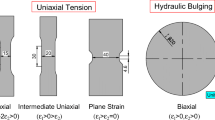Abstract
In this paper, the effects of strain rate on the mechanical properties of DP780 were analyzed by quasi-static tensile test and Hopkinson bar test; Johnson-Cook constitutive model with high strain rate was established. Based on ANSYS/LS-DYNA finite element program, the finite element simulation of electromagnetic forming process of high-strength steel sheet under the action of driving plate was realized, and the influence of various process parameters on the forming height was studied. The results showed that the yield strength and ultimate tensile strength of the material increased with high strain rate, and DP780 high-strength steel had certain strain rate sensitivity. The drive sheet receives the maximum magnetic field force near the outermost two-turn coil. The deformation of high-strength steel plate mainly occurs under the action of impact inertia. The peak forming height increases with the rise of discharge frequency. The increase of the thickness of the drive sheet can reduce the forming efficiency.


















Similar content being viewed by others
Data availability
The data and materials of this paper are available.
References
Chu YT, Sun LY, Li LJ (2019) Lightweight scheme selection for automotive safety structures using a quantifiable multi-objective approach. J Clean Prod 241:118316
Yu HD, Guo YJ, Lai XM (2009) Rate-dependent behavior and constitutive model of DP600 steel at strain rate from 10-4 to 103s-1. J Mater Des 30:2501–2505
Seth M, Vohnout VJ, Daehn GS (2005) Formability of steel sheet in high velocity impact[J]. J Mater Process Technol 168(3):390–400
Rahmaan T, Bardelcik A, Lmbert J, Butcher C, Worswick MJ (2015) Effect of strain rate on flow stress and anisotropy of DP600, TRIP780, and AA5182-O sheet metal alloys. Int J Impact Eng 88:72–90
Verleysen P, Peirs J, Slycken JV, Faes K, Duchene L (2011) Effect of strain rate on the forming behavior of sheet metals. J Mater Process Technol 211:1457–1464
Huh JY, Huh H, Chang SL (2013) Effect of strain rate on plastic anisotropy of advanced high strength steel sheets. Int J Plast 44:23–46
Hyeonil P, Daeyong JL, Se-Jong K, Youngseon L, Young HM (2016) Effect of an aluminum driver sheet on the electromagnetic forming of DP780 steel sheet. J Mater Process Tech 235:158–170
Kim D, Park H, Kim JH, Lee Y, Lee MG (2014) Numerical analysis on electromagnetic forming of automotive sheets with flat spiral coil. Sae Tech Pap 2. https://doi.org/10.4271/2014-01-2013
Psyk V, Risch D, Kinsey BL, Tekkaya AE, Kleiner M (2011) Electromagnetic forming—a review. J Mater Process Tech 211(5):787–829
Shang JH, Daehn G (2011) Electromagnetically assisted sheet metal stamping. J Mater Process Technol 211(5):868–874
Cui XH, Mo JH, Li JJ, Zhao J, Zhu Y, Huang L, Li ZW, Zhong K (2014) Electromagnetic incremental forming (EMIF): a novel aluminum alloy sheet and tube forming technology. J Mater Process Technol 214(2):409–427
Kuang S, Zhu GM, Li SC, Kang YL (2015) Effects of strain rates on mechanical properties and fracture mechanism of DP780 dual phase steel. Mater Eng Perform 24(6):2426–2433
Yan SL, Li HW, Li P, Xue KM (2018) Mechanisms and forming rules of large thin-walled aluminum alloy components in electromagnetic incremental forming. Procedia Manuf 15:1306–1313
Takatsu N, Kato M, Sato K, Tobe T (1988) High-speed forming of metal sheets by electromagnetic force. JSME Int J 31(1):142–148
Inanan G, Baranoglu B, Aydin E (2015) An application of high-power electromagnetic pulse: forming of sheet metal using electromagnetic waves [C]//. International Conference on Electrical and Electronics Engineering. IEEE :284–288. https://doi.org/10.1109/ELECO.2015.7394594
Vohnout VJ (1998) A hybrid quasi-static/dynamic process for forming large sheet metal parts from aluminum Alloys. Dissertation, The Ohio State University, Columbus
Imbert JM, Winkler SL, Worswick MJ (2005) The effect of tool-sheet interaction on damage evolution in electromagnetic forming of aluminum alloy sheet.Journal of. Eng Mater Technol 127(1):146–150
Kuroda M, Uenishi A, Yoshida H, Igarashi A (2006) Ductility of interstitial-free steel under high strain rate tension: experiments and macroscopic modeling with a physically-based consideration. Int J Solids Struct 43(14):4465–4483
Park H, Kim D, Lee J, Kim SJ, Lee Y, Moon YH (2016) Effect of an aluminum driver sheet on the electromagnetic forming of DP780 steel sheet. J Eng Mater Technol 235:158–170
Xu JR, Yu HP, Li CF (2013) Effects of process parameters on electromagnetic forming of AZ31 magnesium alloy sheets at room temperature. Int J Adv Manuf Technol 66:1591–1602
Zhang M (2005) Experimental study on electromagnetic forming of sheet metal. Dissertation, Mechanical Science Research Institute
Chu HY (2003) Research on quality assurance technology of electroform forming of flat pieces. Dissertation, Beijing Industry University
Xie H (2014) Finite element analysis of electromagnetic shrinkage forming of pipe fittings. Dissertation, Jilin University
Xiao SJ (2012) Research on finite element simulation method of plate electromagnetic forming and design and analysis of coils. Dissertation, Huazhong University of Science and Technology
Funding
This work was supported by the National Natural Science Foundation of China.(Award Number: 51465041) and Natural Science Foundation of Jiangxi Provice. (Award Number: 2018ACB21019 and 20192BCBL23002).
Author information
Authors and Affiliations
Contributions
The first author Dahai Liu did the experiment and wrote the paper, the second author Bo Li assisted the first author to complete the paper, and other authors edited and corrected the paper.
Corresponding author
Ethics declarations
Competing interests
The authors declare that they have no conflict of interest.
Ethical approval
Compliance with ethical standards.
Consent to publish
The manuscript is approved by all authors for publication.
Additional information
Publisher’s note
Springer Nature remains neutral with regard to jurisdictional claims in published maps and institutional affiliations.
Rights and permissions
About this article
Cite this article
Liu, D., Li, B., Guo, Z. et al. Finite element analysis on electromagnetic forming of DP780 high-strength steel sheets. Int J Adv Manuf Technol 112, 1617–1629 (2021). https://doi.org/10.1007/s00170-020-06537-7
Received:
Accepted:
Published:
Issue Date:
DOI: https://doi.org/10.1007/s00170-020-06537-7



